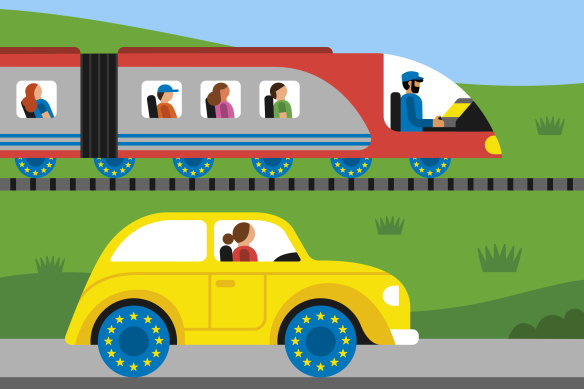Trains v cars: Which is the better option for travelling in Europe?
You won’t have trouble travelling by either road or rail in Europe. Trains are fast, efficient and regular. Motorways are well maintained and widespread, supplemented by good highways and country roads.

Car or train? There are pros and cons for both.Credit: Illustration: Greg Straight
Your carbon footprint is vastly reduced by train travel but, leaving aside eco-considerations, you’ll need to ponder other pros and cons.
Consider the destination. While Europe generally has good rail coverage, there are exceptions, such as Greece, Portugal or Ireland’s scenic west coast. Italy’s good network dwindles as you head south, and a car is a must in the Italian Alps.
How far do you want to go? Train travel is faster and easier if you’re travelling longer distances and zigzagging across the Continent on a whistle-stop tour. It’s less fatiguing too – and a wise idea, at least in the first couple of days, as you get over jet lag.
Major cities are well connected by trains (often high-speed) and have good local public transport. It will take you 6½ hours to drive from Barcelona to Madrid, but only 2½ by train. Paris to Lyon? By road, it’s 4½ hours if you can efficiently find your way out of the city; by train two.
There are more reasons to avoid driving if you’re after an urban holiday. Driving in European cities is stressful and often restricted, and overnight parking is pricey. Medieval towns are equally challenging thanks to one-way streets, cobblestones and tight spaces.
If you prefer to immerse yourself in countryside or Norwegian fjords, however, you’ll prefer the convenience of driving. Roads give you more chances to get off the tourist trail. Spontaneous travellers can stop whenever the spirit takes them to admire views, visit castles or enjoy walks.
If you love dawdling through glorious scenery, rent a car for places such as Portugal’s Algarve, Northern Ireland’s Antrim Coast or Iceland’s Route 1.
The only exception might be Switzerland, which is conveniently networked with railways from valleys to mountain summits. Driving corkscrew alpine roads isn’t everyone’s idea of relaxation, and it distracts from the scenery.
As for cost, there are too many variables for a general rule, but if four people are travelling together, car hire becomes a bargain, although you’ll have to go light on luggage.
Rail travel between major cities is cheap, since trains compete with budget airlines on those routes. By car, petrol and motorway tolls (and potentially ferry crossings) add up if you intend to go far.
Avoid too many point-to-point train tickets, though. If you’re really zipping around, a national or pan-Europe rail pass is better value, and urban public transport and some museum entries are often included.
Finally, how much is stress-free travel worth to you? Driving, navigating and finding parking can be a hassle, if not a cause for divorce. On trains, the passing landscapes get your undivided attention and nobody will breathalyse you. Glass of wine, perhaps?
Sign up for the Traveller newsletter
The latest travel news, tips and inspiration delivered to your inbox. Sign up now.